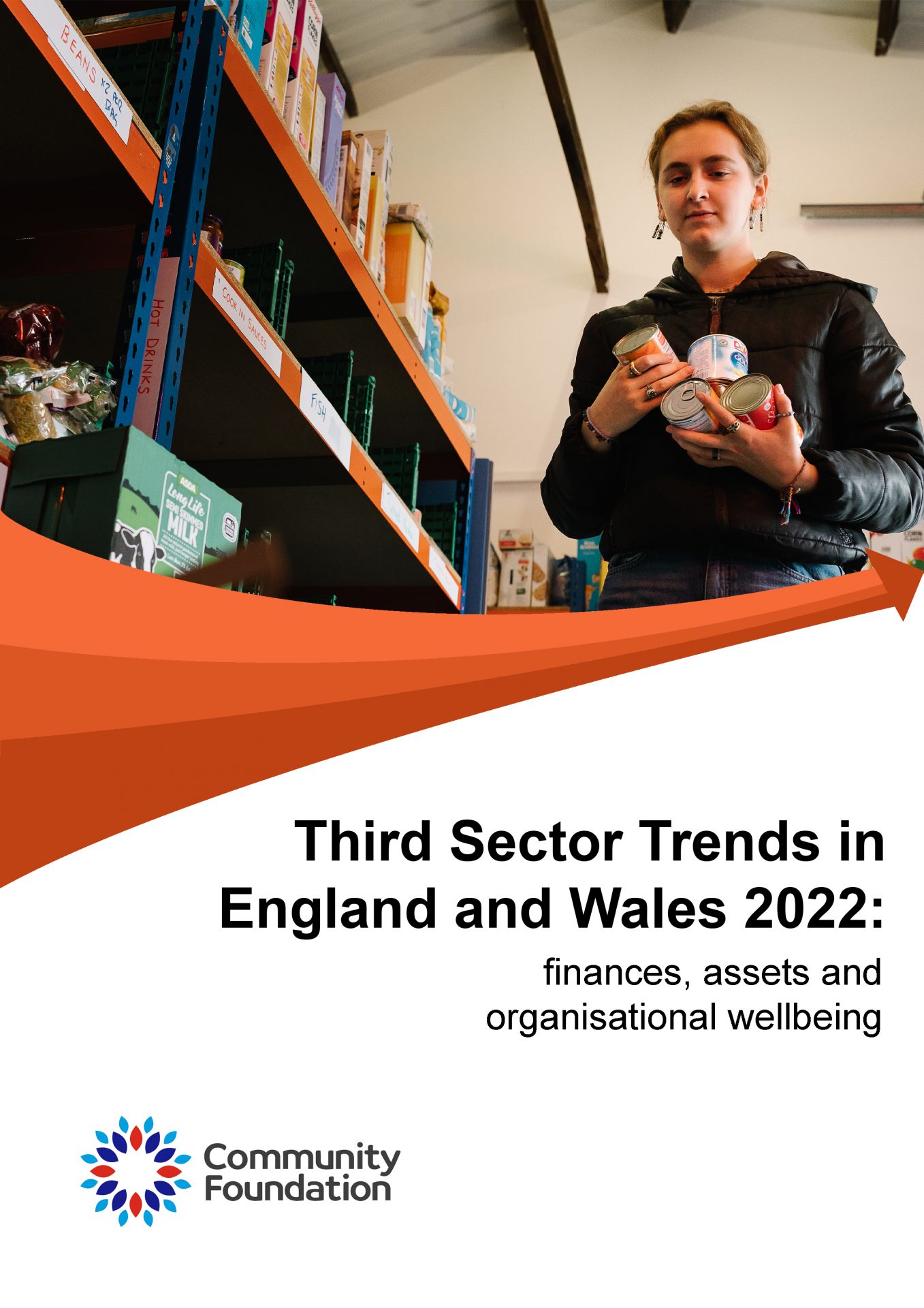Third Sector Trends has been surveying the voluntary, community and social enterprise sector every three years since 2010. In 2022, 6,071 responses were received across England and Wales (an average of ~600 responses in each region). This is the only fully representative longitudinal survey which can produce robust and detailed comparative analysis at a regional and national level.
This is the third of five reports from Third Sector Trends in England and Wales 2022. Headline findings are provided below, but if you want to go straight to the report, here is the link:

Relationships with grant-making trusts and foundations
Relationships with grant funders have changed since 2019. The research shows that many grant makers relaxed their approach to funding during the Covid-19 pandemic (percentages refer to TSOs which ‘agree’ or ‘strongly’ agree with statements).
- In 2019 only 46 per cent of TSOs stated that they received unrestricted or ‘core funding’ compared with 60 per cent in 2022.
- In 2019 only a quarter of TSOs reported that grant funders had approached them. This rose to 40 per cent in 2022.
There is good evidence to show that funders have taken a ‘lighter touch’ to grant-making approach during the pandemic.
- Pressure to provide evidence of impact fell from 55 per cent to 32 per cent.
- Expectations that practice should be ‘innovative’ fell from 74 per cent to 50 per cent.
Some aspects of inter-relationships with grant-making trusts and foundations did not change:
- The percentage of organisations stating that grant makers made a long-term contribution to their work remained about the same between 2019 and 2022 at 31-32 per cent.
As the report concludes:
“The benefits of these changes are plain to see. 83 per cent of organisations have reserves now compared with 76% in 2019. In 2022, 45 per cent of organisations have not drawn on reserves compared with 36% in 2019… The question is, will those grant makers which became more relaxed about how they dispensed their money remain so?
Some grant funders have always operated in a responsive way to the needs of charities and social enterprises and trust them to get things done. Others may be keener again to shape and direct the way their money has an impact on local communities and seek evidence for the changes that were achieved.”
Public service delivery contracts
Political enthusiasm for engaging the Third Sector in the delivery of contracts was at its strongest in the first decade of this century. This policy drive derived from an assumption that TSOs could be incentivised to undertake work for government at local and national level in a ‘mixed economy of welfare’.
Despite government efforts to incentivise and help prepare TSOs to engage in the delivery of contracts, such opportunities still only attract small section of organisations in the Third Sector.
- Due to their purpose and scale of their activities, fewer than 5% of micro and small organisations have been interested in public-service delivery contracts since 2013.
- Medium-sized organisations (income £250,000-£1million) have become progressively less likely to engage in bidding for or delivering contracts – falling from 52% in 2013 to 36% in 2022.
- Only the biggest TSOs (with income above £1million) have sustained involvement in such work (about 60% of bigger organisations in major urban areas and about 50% of bigger organisations nationally.
As the report concludes:
“Organisations that deliver contracts are the most likely to be struggling to retain staff and recruit others. If wages are poor, because contract values are too low, then staff will not be available to deliver them. And to compound this problem, those TSOs which previously chose to subsidise contracts using trading income may struggle now to do this in challenging economic circumstances.”
Earned income from self-generated trading
Self-generated trading includes the delivery of services that clients pay for (such as childcare or community cafes), ticketing for events, rent of space or production and sale of goods.
- About 60 per cent of organisations in the Third Sector earn some of their income by delivering contracts or self-generated trading of goods or services.
- The proportion of TSOs which earn more than 80 per cent of their income from trading has fallen since 2013 from 20% to 14%.
- The overall proportion of organisations which trade has not increased. In fact it has fallen very slightly, but steadily, from 68 per cent in 2013 to 66 per cent in 2022.
As the report concludes:
“The Third Sector’s own trading activity has been affected by the pandemic. Many organisations stopped or reduced trading activity during the worst of the lockdowns. Like private businesses, they were not allowed to open for long periods. And, initially at least, when they reopened fewer customers came.
While Covid-19 may have accelerated change, the pandemic’s effect should not be over-stated nor its impact exaggerated. The proportion of organisations earning income has not increased over the years. In fact it has fallen very slightly and fewer organisations rely very heavily on trading now than in the past. More recently established organisations are less interest in trading than their older counterparts.”
Optimism about future finances
In spite of current difficulties with rising costs of energy and wages, optimism about finances has remained remarkably high.
- 33 per cent of organisations expect that their income will rise over the next two years and 46 per cent think it will stay about the same.
- Only 21 per cent of TSOs think income will fall (and fewer that 5% feel that income will fall substantially).
But as all previous rounds of Third Sector Trends surveys have shown, organisations of all sizes tend to be somewhat ‘over optimistic’ in their projections about future finances.
- In a period of government austerity in 2010, 24% of organisations thought their income would rise, but this only turned out to be 11% of organisations in 2013.
- In 2016, 36% of organisations thought their income would rise in future, but by 2019 only 18% reported that this had happened.
- In 2019, 32% of organisations expected their income would rise. During the pandemic in 2020, optimism collapsed to just 13%. But by 2022, 18% reported that income had risen – the highest level since Third Sector Trends surveys began in 2010.
- When surveyed in 2022, 33% of organisations thought that their income would rise over the next two years. It is too hard to predict what the actual percentage will be.
As Rob Williamson, Chief Executive of the Community Foundation Tyne & Wear and Northumberland, said
“This report shows that the push since 2010 for the future income of the third sector to be based on trading, contracting, social finance and digital fundraising have amounted to very little. We still see the continued importance of grant funding, indeed the model of social finance has evolved into a blended model relying on a mix of grant funding and social finance…
“The pandemic sped up the modernisation of grant funding through trust-based, less restrictive models increasingly focussed on core funding which is a good thing. As funders we need to continue to work and flex alongside the sector to ensure the best outcomes for our communities.”
As the report author, Professor Tony Chapman, concludes:
“Sector over-optimism is not a bad thing because it drives enthusiasm and commitment. But when hopes are dashed, it can make people in the sector feel disappointed…
“Economic conditions are precarious. But this is neither a ‘perfect storm’ nor an ‘existential crisis’. The Third sector is more robust than many commentators think. But there will be a mix of winners and losers as social market conditions change…
“When thinking about sustainability, it should be remembered that Third Sector organisations tend to be financially prudent. More organisations hold reserves in 2019 and that they are ‘holding on tight’ to them rather than investing in new things. And unlike private businesses, very few organisations borrow money which reduces the risk of foreclosure…
“Crucially, organisations have learned over the years how to flex their operations to manage upturns and downturns in their finances because they are so accustomed to high levels of turbulence in their finances. Inevitably, some organisations will have to make redundancies and reduce the level of services they offer…
“So government, local public sector organisations, grant-making trusts and foundations and Third Sector infrastructure agencies need to keep a close eye, as they generally do, on which kinds of organisations may be most at risk. Otherwise, calls for blanket support for all organisations may water down or misdirect the value of such investment from where need is the greatest.”
The report can be downloaded here.
A blog in the implications of the findings can be found here.
